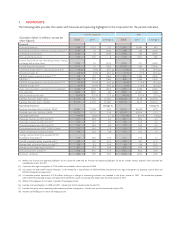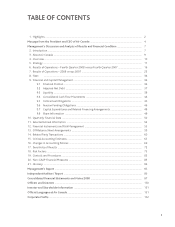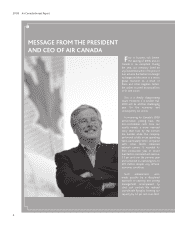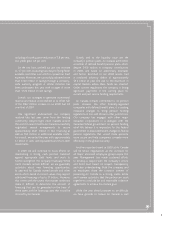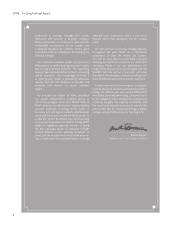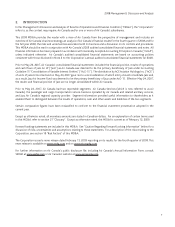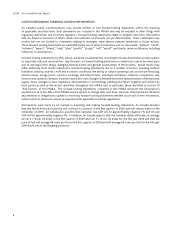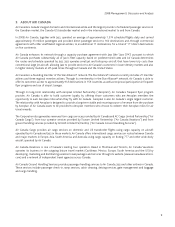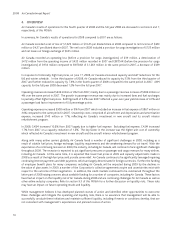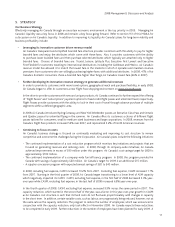Air Canada 2008 Annual Report Download - page 11
Download and view the complete annual report
Please find page 11 of the 2008 Air Canada annual report below. You can navigate through the pages in the report by either clicking on the pages listed below, or by using the keyword search tool below to find specific information within the annual report.
2008 Management’s Discussion and Analysis
11
5. STRATEGY
Our Business Strategy
Effectively managing Air Canada through an uncertain economic environment is the top priority in 2009. Managing Air
Canada’s liquidity was a key focus in 2008 and remains a key focus going forward. Refer to section 9.3 of this MD&A for
a discussion on Air Canada’s liquidity. In addition to improving its liquidity, Air Canada’s plans for long-term viability and
business profitability include:
• Leveragingitsinnovativecustomerdrivenrevenuemodel
Air Canada’s transparent and simplified branded fare structure provides customers with the ability to pay for higher
branded fares and enjoy the attributes which come with these fares. Also, it provides customers with the ability
to purchase lower branded fares and then purchase selected attributes which typically are attached only to higher
branded fares. Choices of branded fares are: Tourist, Leisure, Latitude Plus, Executive First Lowest and Executive
First Flexible for customers traveling to international destinations, including the Caribbean and Mexico. Air Canada’s
revenue model has allowed it to match the lowest fare in the markets in which it operates and maintain revenue
premiums from customers who are willingly purchasing higher fares with additional attributes. In 2008, 47% of Air
Canada’s domestic consumers chose a branded fare higher than Tango, Air Canada’s lowest fare (46% in 2007).
• Furtherdevelopingitsinnovativerevenuestrategytogenerateadditionalrevenues
In order to provide its customers with more travel options, geographical reach and purchase flexibility, in early 2008,
Air Canada began to offer its customers a new Flight Pass shopping environment on www.aircanada.com.
In the drive to provide customers with new and unique products, Air Canada continued to further expand the offering
of “Flight Passes” and “subscriptions” payment options for fixed credit flight passes and unlimited travel, respectively.
Flight Passes provide customers with the ability to lock-in their cost of travel through advance purchase of multiple
segments within a defined geographic area.
In 2008, Air Canada introduced Spring Getaway and New York Weekender passes, an Executive Class Pass and Ontario
and Quebec passes for unlimited flying in the summer. Air Canada offers its customers a choice of different flight
passes tailored for consumers, small to medium-sized businesses and large corporations. In 2008, revenues from Air
Canada’s Flight Pass products increased 52% over 2007, and represented 5.2% of North American revenues.
• Continuingtofocusoncosts
Air Canada’s business strategy is focused on continually evaluating and improving its cost structure to remain
competitive and overcome the challenges facing the Corporation. Air Canada’s plans include the following initiatives:
• Thecontinuedimplementationofacostreductionprogramwhichmonitorskeyinitiativesandprojectsthatare
focused on generating revenues and reducing costs. In 2008, through its company-wide initiatives, Air Canada
achieved improvements in excess of $90 million under this program. Air Canada’s cost savings target for 2009 is
approximately $100 million.
• Thecontinuedimplementationofacompany-widefuelefciencyprogram.In2008,thisprogramprovidedAir
Canada with savings of approximately $20 million. Air Canada’s target for 2009 is an additional $15 million.
• Asupplierconcessionprogramwithexpectedannualsavingsof$20to$40million.
In 2008, including fuel expense, CASM increased 10.2% from 2007. Excluding fuel expense, CASM increased 1.7%
from 2007. Starting in the third quarter of 2008, Air Canada began transitioning to a lower level of ASM capacity
which negatively impacted its CASM. CASM, excluding fuel expense, in the first half of 2008 decreased 3.3% year-
over-year while CASM, excluding fuel expense, in the last half of 2008 increased 6.8% year-over-year.
In the fourth quarter of 2008, CASM, excluding fuel expense, increased 9.9% versus the same period in 2007. The
capacity reduction, which started in the second half of the year, was a factor in this year-over-year growth in CASM
as Air Canada’s cost structure is such that its fixed costs do not fluctuate proportionately with changes in capacity
in the short term. In addition, certain variable costs, such as labour, are progressively being reduced, however, not at
the same rate as the capacity reduction. The program to reduce the number of employees, which was announced in
conjunction with the capacity reduction, only took effect in November 2008. Air Canada expects these reductions
to be completed in early 2009. Further reductions in the number of employees have been planned for early 2009. A


